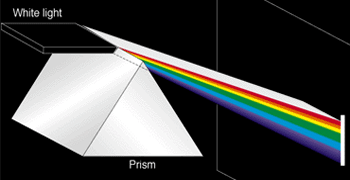What is Diamond | Origins | History | Mining & Distribution | Diamond Jewels
Dispersion
The glinting spectrum or "fire" from a colorless diamond--one of its most valued attributes as a gemstone--results from its excellent dispersion. Dispersion is the division of white light into its component rainbow colors. The greater the dispersion, the greater the separation between the range of colors that are refracted from a gem.

The refractive index can also be used to describe how visible light can be split into the colors of the spectrum when passing through a transparent substance. Basically, this happens because the refractive index of a substance is not constant, but rather varies for different wavelengths, or colors, of light. Therefore, the shorter wavelengths of light (the blue end of the spectrum) are bent more than the longer wavelengths (the red) when entering a colorless substance at an angle. Thus, the colors separate, or disperse, producing the visible range as from a prism. The coefficient of dispersion is a determination of this variation. The greater a substance's coefficient of dispersion, the greater the angular spread of colors from an incoming, tending beam of white light--a characteristic described as a gem's "brilliance."
<< Back | Next >>